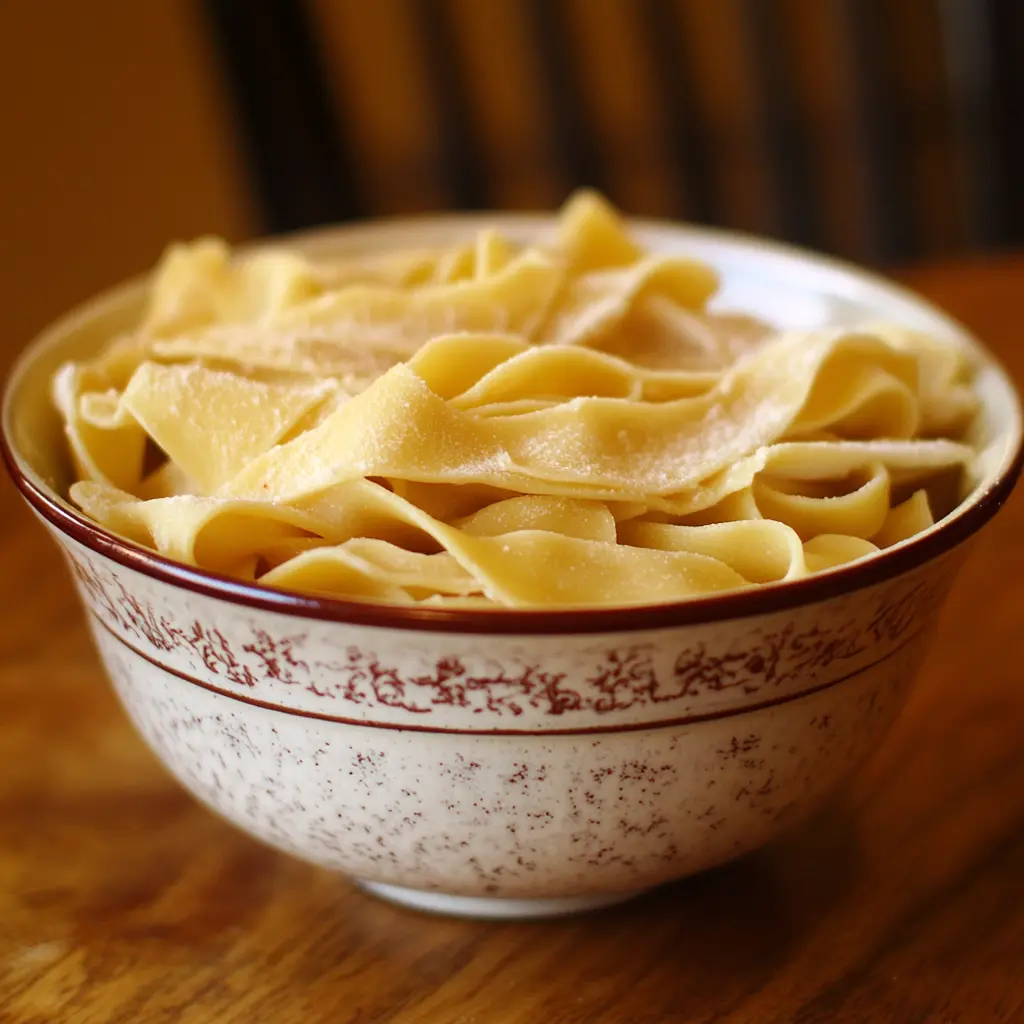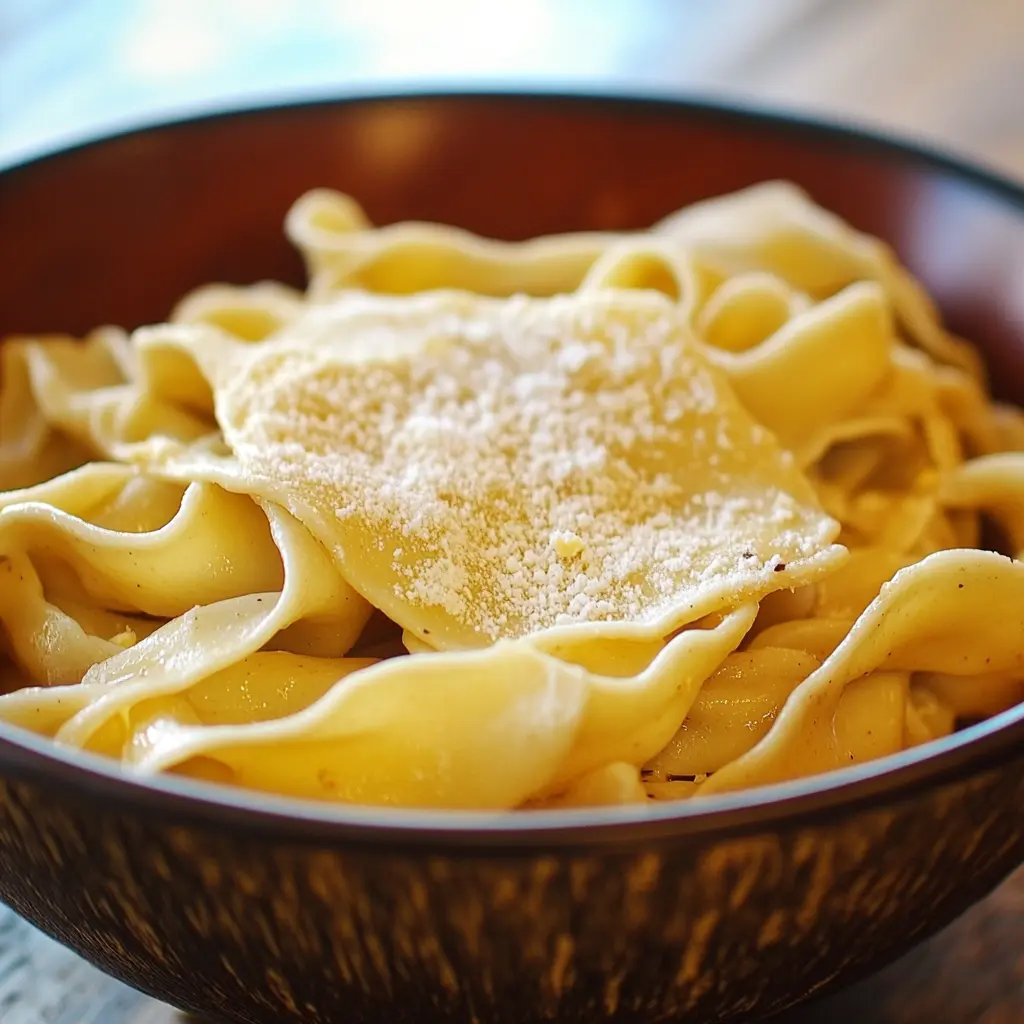Description of this recipe
Homemade egg noodles are a delightful culinary creation that brings warmth and comfort to any meal. With just five simple ingredients, these noodles are easy to make and provide a fresh, hearty alternative to store-bought options. Perfect for soups, casseroles, or as a side dish, these noodles are versatile and can elevate any dish with their rich flavor and satisfying texture.
Why you will love this recipe
You will love this recipe because it captures the essence of homemade cooking—simple, wholesome, and incredibly satisfying. The process of making your own noodles allows you to control the ingredients, ensuring that they are fresh and free from preservatives. Plus, the taste of freshly made noodles is unmatched; they have a tender texture that soaks up flavors beautifully, making every bite a delight. Whether you’re preparing a cozy chicken soup or a hearty pasta dish, these egg noodles will become a staple in your kitchen.
Introduction
There’s something magical about homemade pasta. The act of mixing, rolling, and cutting dough is not just a cooking process; it’s a bonding experience with your kitchen and a way to connect with tradition. Egg noodles, in particular, have a rich history and are a staple in many cuisines around the world. Making your own egg noodles can seem daunting, but with this simple recipe, you’ll find that it’s an enjoyable and rewarding task. The best part? You only need five ingredients, and the result is a batch of delicious, homemade noodles that can be used in a variety of dishes. Let’s dive into the process of creating these delightful noodles from scratch!
Ingredients:
- 1 large egg
- 2 large egg yolks
- 3 tablespoons cold water
- 1 teaspoon salt
- 2 cups all-purpose flour (plus extra for dusting)
Preparation:
Step 1: In a large mixing bowl, crack the whole egg and add the two egg yolks. Using a whisk or fork, beat the eggs until they are light and fluffy. This step is crucial as it incorporates air into the eggs, which will help give your noodles a light texture.
Step 2: Add the cold water and salt to the beaten eggs. Mix until combined. The cold water helps to keep the dough firm and manageable, making it easier to roll out later.
Step 3: Gradually add the flour to the egg mixture, stirring with a wooden spoon or your hands until a shaggy dough forms. You may not need to use all the flour; the goal is to achieve a dough that is not sticky but still pliable.
Step 4: Transfer the dough to a lightly floured surface and knead it for about 5-7 minutes until it becomes smooth and elastic. If the dough feels too sticky, sprinkle a little more flour as needed. This kneading process develops the gluten in the flour, which gives the noodles their structure.
Step 5: Roll out the dough on a floured surface to about 1/8-inch thickness. Use a rolling pin to ensure an even thickness. Once rolled out, cut the dough into strips using a pizza cutter or a sharp knife. You can make them as wide or narrow as you prefer. Dust the cut noodles with a little flour to prevent them from sticking together. At this point, you can store the noodles in the fridge for 2-3 days or freeze them for 1-2 months. To cook, simply drop them into boiling water and cook for 7-9 minutes until tender.
Serving Suggestions:
Homemade egg noodles are incredibly versatile. They shine in classic chicken noodle soup, where they absorb the flavorful broth beautifully. You can also pair them with a rich beef stew, toss them with a creamy Alfredo sauce, or serve them with a light garlic and olive oil dressing for a simple yet satisfying dish. For a twist, try adding sautéed vegetables and protein of your choice for a complete meal.
Tips:
- Ensure your dough is well-kneaded for the best texture. A good knead develops gluten and gives the noodles their chewiness.
- Use a pasta machine for rolling out the dough if you have one; it can make the process easier and ensure even thickness.
- If you plan to freeze the noodles, lay them flat on a baking sheet until frozen, then transfer them to a freezer-safe bag. This prevents them from clumping together.
- Experiment with flavors by adding herbs or spices to the dough for a unique twist!
Prep Time: 15 minutes
Cook Time: 7-9 minutes
Total Time: 25 minutes
Nutritional Information (per serving):
Calories: 200
Protein: 8g
Sodium: 200mg
(Note: Nutritional values may vary based on specific ingredients used and portion sizes.)
Conclusion
Homemade egg noodles are a delightful addition to your culinary repertoire. With just five ingredients and a straightforward process, you can create a comforting, delicious base for countless meals. Whether you’re enjoying them in a warm bowl of soup or dressed up with your favorite sauce, these noodles will surely bring joy to your table. So roll up your sleeves, gather your ingredients, and enjoy the wonderful experience of making your own pasta at home!
Questions and Answers about this recipe:
- Can I use whole wheat flour instead of all-purpose flour?
Yes, you can substitute whole wheat flour for all-purpose flour. However, the texture may be slightly different, and you might need to adjust the amount of water used, as whole wheat flour absorbs more moisture. - How do I store leftover noodles?
You can store leftover noodles in an airtight container in the refrigerator for up to 3 days. If you want to keep them longer, freeze them by laying them flat on a baking sheet until frozen, then transfer them to a freezer-safe bag. - What can I serve with homemade egg noodles?
Homemade egg noodles are versatile! They are excellent in chicken noodle soup, beef stew, or tossed with a sauce like Alfredo or marinara. You can also serve them with sautéed vegetables or in a stir-fry. - Can I make the dough ahead of time?
Absolutely! You can make the dough ahead of time and store it in the refrigerator for up to 2 days. Just make sure to wrap it tightly in plastic wrap to prevent it from drying out. - Why do I need to knead the dough?
Kneading the dough is essential as it develops the gluten in the flour, which gives the noodles their structure and chewy texture. Proper kneading ensures that your noodles won’t fall apart when cooked.

